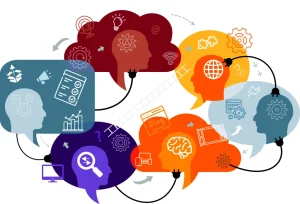HR in Team Augmentation: Best Practices
Introduction Team augmentation has become a popular approach for companies looking to expand their workforce without hiring full-time staff. It allows companies to bring in ou...

Introduction
Team augmentation has become a popular approach for companies looking to expand their workforce without hiring full-time staff. It allows companies to bring in outside expertise for specific projects or tasks while maintaining flexibility and reducing costs. However, successful team augmentation requires more than just finding qualified professionals. Human resources (HR) plays a critical role in ensuring the smooth and effective integration of external talent.
In this article, we will look at best practices for HR in team augmentation, as well as potential pitfalls to avoid.
Best Practices for HR in Team Augmentation
1. Clear Communication from the Start
When adding augmented team members, it is important to establish clear lines of communication. HR should ensure that both internal employees and extended team members understand their roles, responsibilities, and expectations. Open communication helps prevent misunderstandings and promotes collaboration.
One effective way to do this is to set up regular check-ins and meetings to review progress and address any issues. Not only does this ensure everyone is on the same page, it also promotes a sense of unity within the team.

2. Define a Comprehensive Onboarding Process
While augmented teams may not be permanent employees, they still need a thorough onboarding process. HR should ensure that external talent is familiar with the company’s culture, tools, and processes. A well-structured onboarding program can help them hit the ground running while minimising the learning curve.
This onboarding process should also include introductions to key stakeholders and team members, as well as access to the necessary resources. A smooth onboarding process sets the stage for success and helps augmented talent feel like a valued part of the team.
3. Aligning Augmented Team Members with Company Culture
Cultural integration is often overlooked during team expansion, but it is critical to long-term success. HR in team augmentation should focus on aligning augmented members with the company’s values and work culture. Even if these professionals may only be with the company temporarily, cultural alignment ensures smoother collaboration and reduces friction between internal and external teams.
Encouraging augmented team members to participate in team-building activities and social events can help them feel more connected to the company and its mission. This sense of belonging can lead to higher engagement and better performance.

4. Maintain Flexibility and Adaptability
HR must ensure that the team growth strategy remains flexible. Project requirements may change, requiring roles to be changed or new skills to be added. HR must work closely with project managers to monitor team needs and adjust the composition of augmented talent as needed.
This flexibility extends to contract terms as well. HR in team augmentation must be prepared to renegotiate or extend contracts if necessary, but also have clear guidelines for reducing the team after the project is completed. Having a clearly defined exit strategy for augmented team members is equally important to avoid disruption after the project is completed.
5. Facilitate Knowledge Transfer
One of the challenges of team augmentation is ensuring that the knowledge gained by augmented experts is retained within the company. HR should facilitate knowledge transfer between the extended team members and the permanent staff. This can be achieved through documentation, training sessions, and collaboration.
Encouraging ongoing collaboration between the in-house staff and augmented experts can help to bridge any knowledge gaps. This ensures that even after the extended team members leave, the company retains the expertise gained during the project.

HR in Team Augmentation: Pitfalls to Avoid
1. Failure to Provide Role Clarity
A common mistake when augmenting a team is unclear role definitions. If the roles and responsibilities of external team members are not clearly defined, this can lead to confusion, duplication of effort, or missed tasks. HR should work with department heads and project managers to clearly outline what each member of the augmented team is expected to do and how their work fits into the overall project.
Without this clarity, collaboration between internal and external team members can suffer, leading to inefficiencies and a lack of accountability.
2. Underestimating the Importance of Contracts
Another major pitfall is inadequate contracts or agreements. HR in team augmentation must ensure that all members of the extended team have clear, legally binding contracts that outline their roles, compensation, length of service, and confidentiality agreements. Neglecting this aspect can lead to legal issues, pay disputes, or data security issues.
Carefully drafted contracts protect both the company and the external talent by ensuring that expectations are set from the start.

3. Ignoring Long-Term Planning
While team augmentation is often viewed as a short-term solution, HR should not ignore the long-term implications. If external talent is needed for ongoing projects, it is important to consider how these specialists will fit into the company’s long-term plans. Constant turnover of augmented team members can create instability that can hinder project progress.
Instead, HR in team augmentation should explore options for extending contracts or making augmented specialists permanent if their contributions will be valuable for future projects.
4. Neglecting Feedback Mechanisms
Regular feedback is essential to the success of any team, and this is especially true for extended teams. HR should implement mechanisms to collect feedback from both internal staff and external team members. This helps identify any issues early on and provides an opportunity for continuous improvement.
By developing a culture of open feedback, HR in team augmentation can ensure that the team remains aligned and that any roadblocks are addressed promptly.

5. Mismanaging Team Dynamics
Finally, mismanaging team dynamics is a common mistake when team augmenting. Bringing in external talent can sometimes create tensions among internal staff, especially if there is a perceived threat to job security. HR in team augmentation should be proactive in managing these dynamics by encouraging collaboration and emphasising that augmented team members should complement, not replace, the internal team.
Promoting transparency and open communication can help alleviate concerns and ensure a harmonious work environment.
Conclusion
HR in team augmentation plays a key role in the success. By following best practices such as clear communication, proper onboarding, and promoting cultural alignment, HR can ensure that augmented talent integrates smoothly with the internal team. At the same time, avoiding pitfalls such as unclear role definitions, inadequate contracts, and poor feedback mechanisms is critical to maintaining a productive and cohesive workforce.
In the fast-changing world of business, team augmentation provides the flexibility and expertise needed to remain competitive. With HR in team augmentation at the helm, companies can make the most of this strategy while avoiding common pitfalls.